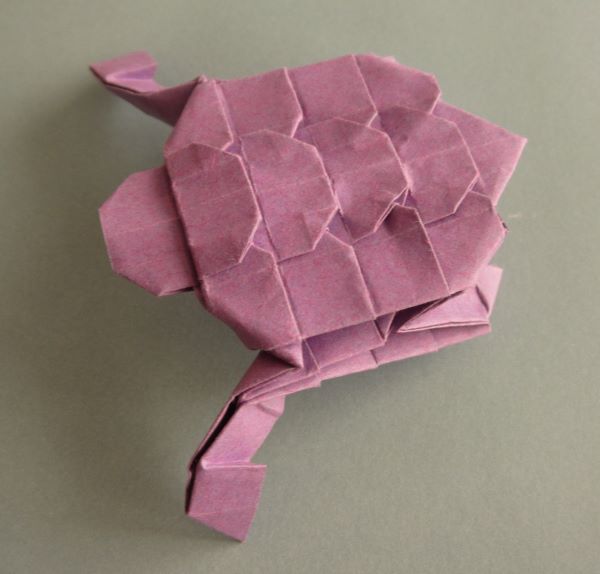
Turtle, designer unknown. ETA: I have identified the model as Baby Sea Turtle by Neige A.
You know, I posted a sketch of this same model, but I don’t think I had ever posted a photo of the model itself? Well, here it is.
As I mentioned before, someone at the origami meetup taught me how to make this. If I recall correctly, he did not represent himself as the designer, which leaves the designer unknown to me. I could not find any similar models online. Nor do I remember quite how to make it. That said, I could probably reverse engineer it if needed.
This model is created using box pleating and pattern grafting. Now what does any of that mean? Box pleating is a method that uses a lot of folds at 90 degrees from one another. Pattern grafting means that before doing anything else, I fold a little pattern on the paper, which eventually become the scales on the turtle shell.
I have about four distinct turtle designs in my collection, but this is my favorite one. I like the combination of fine detail and overall abstract simplified shape.

I think that is the most turtle-ey origami turtle I have seen, the legs in particular are just right, which is important in distinguishing the shape from the similar tortoise.
Here’s an origami question, what do you do if you’re in the middle of folding something, and then you realize the paper is not perfectly square? Whenever that has happened to me, I always felt like “well I wasn’t gonna fold this very exact anyway, so whatever, but I bet people who are good at origami would get mad about the paper not being square.”
@Perfect Number,
Some kinds of paper (especially when I cut the squares myself) have slight but noticeable deviations from squareness. But it doesn’t really bother me, because the more significant source of error comes from folding imprecision, and the thickness of the paper. Error is largely unavoidable.
I suppose there are three main approaches to dealing with the error: 1) Fold through it. 2) Adjust existing creases to fix it. 3) Give up and try again. It may help to fold a little further so that when I try again I have a better understanding of the model.
Folding through an error can give you some choices. For instance, if a piece of paper is slightly rectangular, and the first fold is diagonal, do you: a) make one corner touch the other b) make the crease go from corner to corner, or c) split the difference? Generally, the most important thing early on is where the crease lands, so option b is correct. In more complicated cases, I just have to make some judgment.